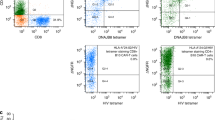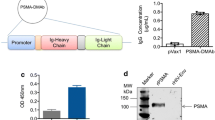Abstract
We previously described PASD1 as a new cancer testis antigen in multiple myeloma (MM) that is retained post-therapy, suggesting the use of vaccination strategies to induce anti-PASD1 immunity in a setting of minimal residual disease. We have focused on DNA fusion gene vaccines, coupling fragment C domain (DOM) of tetanus toxin with PASD1 sequence, and examined efficacy in Human Leukocyte Antigen (HLA)-A2 (HHD) transgenic mice using a human MM cell line expressing PASD1 protein and chimeric HLA-A2 class I molecules as target. DNA vaccines encoded two HLA-A2-restricted epitopes (p.DOM-PASD1(1), p.DOM-PASD1(2)) and full-length PASD1 (p.DOM-PASD1FL). p.DOM-PASD1(1) proved superior to p.DOM-PASD1(2) in generating T-cell responses in HHD mice, able to lyse the chimeric murine RMA-HHD cells. Boosting by electroporation significantly enhanced p.DOM-PASD1(1). Only p.DOM-PASD1(1) induced cytotoxic T-lymphocytes (CTLs) were able to lyse human MM target cells expressing endogenous antigen. The p.DOM-PASD1FL vaccine predominantly induced strong PASD1(1) over PASD1(2) T-cell immune responses, indicative of immunodominance. Importantly, p.DOM-PASD1FL generated immune-mediating killing of native chimeric MM cells, in the absence of exogenous added peptide, implicating PASD1(1) specific CTLs. These data demonstrate that PASD1-derived epitopes are both efficiently and selectively processed and presented by native human MM cells. Notably, they permit the use of PASD1-encoding DNA vaccine therapy in a clinical setting.






Similar content being viewed by others
References
Sirohi B, Powles R . Multiple myeloma. Lancet 2004; 363: 875–887.
Kyle RA, Rajkumar SV . Multiple myeloma. Blood 2008; 111: 2962–2972.
Rice J, King CA, Spellerberg MB, Fairweather N, Stevenson FK . Manipulation of pathogen-derived genes to influence antigen presentation via DNA vaccines. Vaccine 1999; 17: 3030–3038.
Spellerberg MB, Zhu D, Thompsett A, King CA, Hamblin TJ, Stevenson FK . DNA vaccines against lymphoma: promotion of anti-idiotypic antibody responses induced by single chain Fv genes by fusion to tetanus toxin fragment C. J Immunol 1997; 159: 1885–1892.
King CA, Spellerberg MB, Zhu D, Rice J, Sahota SS, Thompsett AR et al. DNA vaccines with single-chain Fv fused to fragment C of tetanus toxin induce protective immunity against lymphoma and myeloma. Nat Med 1998; 4: 1281–1286.
Rice J, Buchan S, Dewchand H, Simpson E, Stevenson FK . DNA fusion vaccines induce targeted epitope-specific CTLs against minor histocompatibility antigens from a normal or tolerized repertoire. J Immunol 2004; 173: 4492–4499.
Rice J, Dossett ML, Ohlen C, Buchan SL, Kendall TJ, Dunn SN et al. DNA fusion gene vaccination mobilizes effective anti-leukemic cytotoxic T lymphocytes from a tolerized repertoire. Eur J Immunol 2008; 38: 2118–2130.
Rice J, Elliott T, Buchan S, Stevenson FK . DNA fusion vaccine designed to induce cytotoxic T cell responses against defined peptide motifs: implications for cancer vaccines. J Immunol 2001; 167: 1558–1565.
Low L, Mander A, McCann K, Dearnaley D, Tjelle T, Mathiesen I et al. DNA vaccination with electroporation induces increased antibody responses in patients with prostate cancer. Hum Gene Ther 2009; 20: 1269–1278.
Chen YT, Gure AO, Tsang S, Stockert E, Jager E, Knuth A et al. Identification of multiple cancer/testis antigens by allogeneic antibody screening of a melanoma cell line library. Proc Natl Acad Sci USA 1998; 95: 6919–6923.
Condomines M, Hose D, Reme T, Requirand G, Hundemer M, Schoenhals M et al. Gene expression profiling and real-time PCR analyses identify novel potential cancer-testis antigens in multiple myeloma. J Immunol 2009; 183: 832–840.
Scanlan MJ, Gure AO, Jungbluth AA, Old LJ, Chen YT . Cancer/testis antigens: an expanding family of targets for cancer immunotherapy. Immunol Rev 2002; 188: 22–32.
Suri A . Cancer testis antigens—their importance in immunotherapy and in the early detection of cancer. Expert Opin Biol Ther 2006; 6: 379–389.
Scanlan MJ, Simpson AJ, Old LJ . The cancer/testis genes: review, standardization, and commentary. Cancer Immun 2004; 4: 1.
Goodyear OC, Pratt G, McLarnon A, Cook M, Piper K, Moss P . Differential pattern of CD4+ and CD8+ T-cell immunity to MAGE-A1/A2/A3 in patients with monoclonal gammopathy of undetermined significance (MGUS) and multiple myeloma. Blood 2008; 112: 3362–3372.
Sahota SS, Goonewardena CM, Cooper CD, Liggins AP, Ait-Tahar K, Zojer N et al. PASD1 is a potential multiple myeloma-associated antigen. Blood 2006; 108: 3953–3955.
Liggins AP, Brown PJ, Asker K, Pulford K, Banham AH . A novel diffuse large B-cell lymphoma-associated cancer testis antigen encoding a PAS domain protein. Br J Cancer 2004; 91: 141–149.
Cooper CD, Liggins AP, Ait-Tahar K, Roncador G, Banham AH, Pulford K . PASD1, a DLBCL-associated cancer testis antigen and candidate for lymphoma immunotherapy. Leukemia 2006; 20: 2172–2174.
Pascolo S, Bervas N, Ure JM, Smith AG, Lemonnier FA, Perarnau B . HLA-A2.1-restricted education and cytolytic activity of CD8(+) T lymphocytes from beta2 microglobulin (beta2m) HLA-A2.1 monochain transgenic H-2Db beta2m double knockout mice. J Exp Med 1997; 185: 2043–2051.
Ait-Tahar K, Liggins AP, Collins GP, Campbell A, Barnardo M, Lawrie C et al. Cytolytic T-cell response to the PASD1 cancer testis antigen in patients with diffuse large B-cell lymphoma. Br J Haematol 2009; 146: 396–407.
Buchan S, Gronevik E, Mathiesen I, King CA, Stevenson FK, Rice J . Electroporation as a ‘prime/boost’ strategy for naked DNA vaccination against a tumor antigen. J Immunol 2005; 174: 6292–6298.
Dhodapkar MV, Osman K, Teruya-Feldstein J, Filippa D, Hedvat CV, Iversen K et al. Expression of cancer/testis antigens MAGE-A1, MAGE-A3, MAGE-A4, CT-7, and NY-ESO-1 in malignant gammopathies is heterogeneous and correlates with site, stage and risk status of disease. Cancer Immun 2003; 3: 9.
Radcliffe JN, Roddick JS, Friedmann PS, Stevenson FK, Thirdborough SM . Prime-boost with alternating DNA vaccines designed to engage different antigen presentation pathways generates high frequencies of peptide-specific CD8+ T cells. J Immunol 2006; 177: 6626–6633.
Palmowski MJ, Choi EM, Hermans IF, Gilbert SC, Chen JL, Gileadi U et al. Competition between CTL narrows the immune response induced by prime-boost vaccination protocols. J Immunol 2002; 168: 4391–4398.
Stevenson FK, Ottensmeier CH, Rice J . DNA vaccines against cancer come of age. Curr Opin Immunol 2010; 22: 264–270.
Landgren O, Kyle RA, Pfeiffer RM, Katzmann JA, Caporaso NE, Hayes RB et al. Monoclonal gammopathy of undetermined significance (MGUS) consistently precedes multiple myeloma: a prospective study. Blood 2009; 113: 5412–5417.
Spisek R, Kukreja A, Chen LC, Matthews P, Mazumder A, Vesole D et al. Frequent and specific immunity to the embryonal stem cell-associated antigen SOX2 in patients with monoclonal gammopathy. J Exp Med 2007; 204: 831–840.
Lendvai N, Gnjatic S, Ritter E, Mangone M, Austin W, Reyner K et al. Cellular immune responses against CT7 (MAGE-C1) and humoral responses against other cancer-testis antigens in multiple myeloma patients. Cancer Immun 2010; 10: 4.
Small EJ, Schellhammer PF, Higano CS, Redfern CH, Nemunaitis JJ, Valone FH et al. Placebo-controlled phase III trial of immunologic therapy with sipuleucel-T (APC8015) in patients with metastatic, asymptomatic hormone refractory prostate cancer. J Clin Oncol 2006; 24: 3089–3094.
Administration. UFaD. FDA labelling information—Provenge. FDA website (online), http://www.fda.gov/downloads/BiologicsBloodVaccines/CellularGeneTherapyProducts/ApprovedProducts/UCM210031.pdf, 2010.
Acknowledgements
Funding: Leukaemia & Lymphoma Research (UK), EU FP6 Grant 037602 (MSCNET).
Author information
Authors and Affiliations
Corresponding author
Ethics declarations
Competing interests
The authors declare no conflict of interest.
Rights and permissions
About this article
Cite this article
Joseph-Pietras, D., Gao, Y., Zojer, N. et al. DNA vaccines to target the cancer testis antigen PASD1 in human multiple myeloma. Leukemia 24, 1951–1959 (2010). https://doi.org/10.1038/leu.2010.196
Received:
Revised:
Accepted:
Published:
Issue Date:
DOI: https://doi.org/10.1038/leu.2010.196
- Springer Nature Limited




